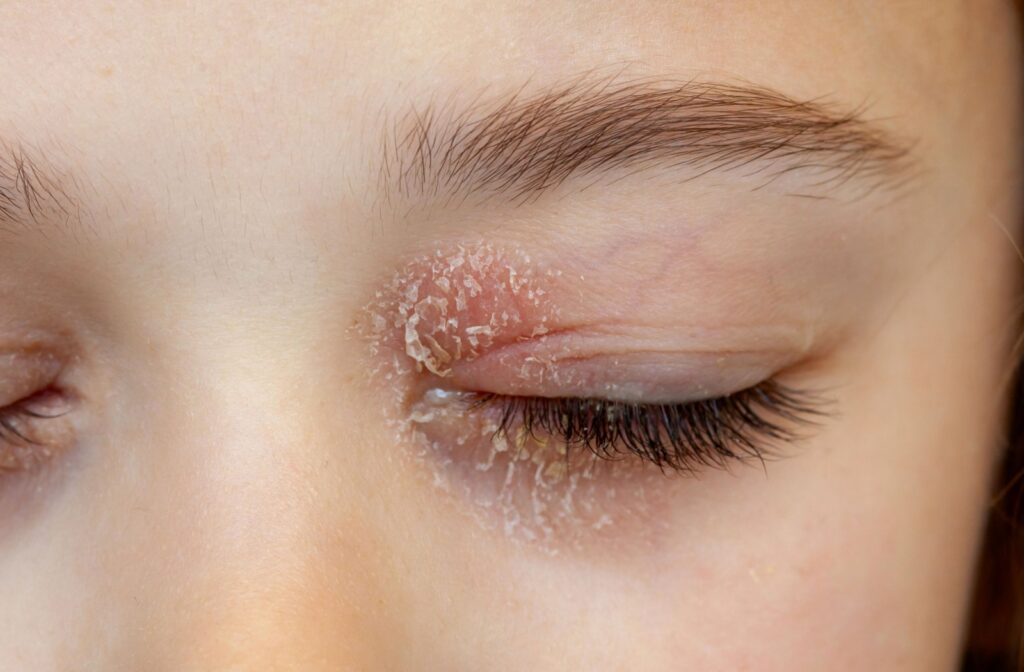Red, swollen eyelids, burning sensations, and crusty lashes can be uncomfortable and often confusing. These symptoms can resemble more serious infections, leaving many people unsure about whether their condition is something they might pass on.
Sometimes, those symptoms can be a sign of blepharitis. Blepharitis is not contagious and cannot be spread from person to person. Instead, it’s caused by internal factors like clogged oil glands, bacterial overgrowth, or skin conditions.
Understanding what sets blepharitis apart from infectious eye conditions is key to finding relief and protecting your long-term eye health. Often, scheduling an eye exam, or eye exam for your child, can be a good first step to managing and preventing blepharitis in the future.
What Is Blepharitis?
Not all cases of blepharitis are the same, and understanding its two main types can help you get on the right track toward managing symptoms:
Anterior Blepharitis
This type affects the outer edge of the eyelid, where the eyelashes are attached. It’s usually caused by bacteria, scalp dandruff, or, less commonly, by tiny mites called Demodex.
Symptoms typically include redness, crusting, and irritation at the lash line. People with anterior blepharitis may also notice flakes resembling dandruff at the base of their eyelashes.
Posterior Blepharitis
Posterior blepharitis occurs on the inner edge of the eyelids, where the eyelids come into contact with the eye. This type is often the result of meibomian gland dysfunction, where the glands that produce oils to protect the eye become clogged or aren’t working properly.
Posterior blepharitis is commonly associated with skin conditions like rosacea or seborrheic dermatitis and can lead to dry eyes and eyelid irritation.
Some people experience one type of blepharitis, while others may deal with both at the same time, further complicating symptoms.
Causes of Blepharitis
Blepharitis isn’t caused by a single factor. Instead, a combination of issues may contribute to the condition. Some common causes include:
- Bacterial overgrowth: An overgrowth of bacteria, especially Staphylococcus, on the skin or lash line often leads to anterior blepharitis.
- Meibomian Gland Dysfunction (MGD): When the meibomian glands become clogged, the result can be posterior blepharitis, which disrupts the tear film and causes irritation.
- Skin Conditions: Conditions like rosacea and seborrheic dermatitis often play a role in aggravating blepharitis.
- Eyelash Mites: Naturally occurring mites, called Demodex, may contribute to inflammation when they multiply excessively.
These factors contribute to the body’s inflammatory response, but because blepharitis isn’t caused by an infectious pathogen like viruses or bacteria that spread from one person to another, it is not contagious.
Common Symptoms & How It’s Diagnosed
Blepharitis comes with hallmark symptoms that can vary in severity but are often bothersome. Knowing what to look for can help you catch it early and seek professional care when needed.
Common Symptoms
- Red, swollen eyelids
- Burning sensations
- Crusty flakes at the base of the eyelashes
- A gritty feeling in the eyes
- Light sensitivity
- Excessive tearing
- Dry eyes or irritation
Symptoms might affect one or both eyes, and they’re often worse in the morning. Many people describe it as feeling like there’s something stuck in their eye.
Diagnosis
An optometrist will conduct a thorough examination to confirm blepharitis. This involves looking at the eyelid margins, assessing tear film stability, and determining whether bacteria, oil gland dysfunction, or mites are contributing factors. Physical examination and sometimes a swab of the eyelid for testing can provide clarity on the cause.

Treatment & Management
Blepharitis is a chronic condition, meaning it doesn’t go away completely. However, with the right care routine, symptoms can be well-managed. Here’s how to keep it under control:
Eye Hygiene
- Warm compresses: Applying a clean, warm compress to your eyelids can help loosen crusts and unblock clogged oil glands.
- Gentle cleansing: Use a diluted baby shampoo or a specially formulated eyelid cleanser to clean the lash line and reduce bacterial buildup.
Address Underlying Conditions
Managing related conditions like dandruff, rosacea, or seborrheic dermatitis is important for helping control and manage blepharitis. Speak with an eye professional about treatment options.
Prescription Treatments
For more persistent cases, your eye doctor may recommend:
- Antibiotic ointments or drops
- Anti-inflammatory eye drops or medications
- Artificial tears for dry eyes
Sticking to a consistent hygiene routine and addressing underlying causes can help significantly reduce flare-ups and improve comfort.
Preventing Blepharitis
Preventive care is your best ally in avoiding blepharitis symptoms. Incorporating a few simple habits into your daily routine can make a difference:
- Commit to regular eyelid hygiene, using warm compresses and cleansers.
- Manage any skin conditions with the help of a dermatologist.
- Avoid eye irritants like smoke, allergens, and harsh cosmetics.
- Follow proper contact lens hygiene practices.
- Schedule regular comprehensive eye exams to catch potential issues early.
Taking proactive steps can help control symptoms and improve your overall eye health.
Book Your Eye Exam Today
With the right treatment and regular care, you can manage symptoms of blepharitis and maintain healthy eyes.
At Willoughby Doctors of Optometry, our experienced team is here to help you every step of the way. Our personalized care plans focus on education, proactive management, and comprehensive eye exams to address conditions like blepharitis early.
If you’re dealing with symptoms of blepharitis or have concerns about your eye health, don’t hesitate to book your appointment today.











